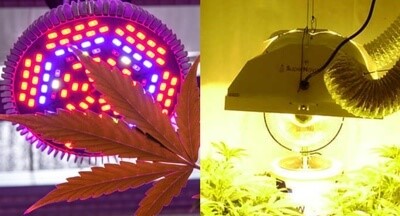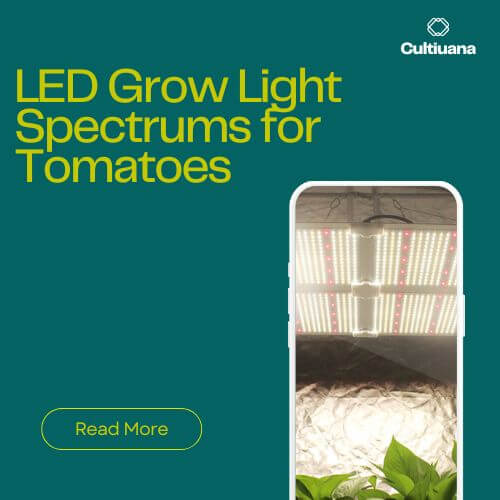
LED Grow Light vs HPS: A Comprehensive Comparison
When it comes to creating a beautiful and healthy garden, the question of whether to use LED Grow Lights or HPS lights is an ongoing debate.
This article provides a detailed comparison between the two choices. Covering differences between LED and HPS, how they impact plant growth, cost-efficiency, and frequently asked questions.
We'll start by exploring the basics of HPS and LED Grow Lights and then examine their impact on plant life.
In addition, we'll discuss their environmental impact, potential yields, and other practical considerations to help you make the right choice of lighting for your needs.
What Are the Differences Between HPS and LED Grow Light?
What is the principle of HPS?
HPS stands for High Pressure Sodium Lamp. Once switched on and activated, an HPS lamp generates an electric arc between both electrodes at either end of its arc tube - this process occurs instantly upon power up!
Due to the high temperature effect of an arc, sodium amalgam inside of a tube is heated and evaporated into mercury and sodium vapor, producing mercury vapor and sodium vapor respectively.
Electrons released by a cathode collide with mercury vapor and sodium vapor atoms when moving towards an anode, gaining energy and creating an excitation state before returning back into their stable states.
Excited states eventually return back down towards ground states while excess energy released as light radiation results from these reactions.

What is the principle of LED Grow Light?
LED is short for light emitting diode and works by injecting and recombining electrons through semiconductor materials to emit light. LED grow lights emit different wavelengths that can be tailored specifically for plant growth needs.
LED grow lights are highly efficient and environmentally friendly. As a semiconductor device, they emit light through the injection and recombination of electrons in materials that do not contain harmful elements.
With a lifespan of up to 100,000 hours, they are a durable and low-maintenance option for indoor gardening.
The wavelengths emitted by LED grow lights can also be adjusted to meet the specific needs of plants, resulting in healthier and more abundant growth.

LED Grow Light And HPS Performance
Due to their intense light output intensity and heat output, HPS lamps must be installed at an appropriate height away from plants for best performance.
A suitable optical design may enable multiple HPS lamps to cover an expansive area using just a single HPS light source.
LED grow lights offer efficient light output at lower energy usage than HPS fixtures, helping save both power and money in their use.
Their adjustable spectrum enables plants to have exactly what they require for growth allowing for precise satisfaction of plant needs.
The Help of LED and HPS on Plant Growth
One of the limitations that HPS grow lights have is their fixed spectrum. HPS grow light is that they have a fixed spectrum that cannot be tuned or dimmed to fit different levels of growth.
On the other hand, LED grow lights can produce a broad range of spectrum, which can be adjusted to meet the requirements of various phases of growth, making them more efficient in terms of quality and yield of the plant buds.
Cost of LED and HPS
Initial investment
HPS lights have a lower upfront cost compared to LED lights. However, over the course of 5 years, LED lights end up being a more cost-effective choice than HPS lights due to their longer lifespan and minimal accessory replacements.
With HPS lights, bulbs need to be replaced every 10,000 hours and ballasts every 20,000-30,000 hours, resulting in frequent labor and replacement costs.

Lifespan of LED And HPS
LED lamps last significantly longer than HPS lamps, with an average lifespan of around 50,000 hours compared to the relatively short lifespan of around 10,000 hours for HPS lamps.
Eco-Friendly?
LED lights are a more eco-friendly than HPS grow lights. They're free from heavy metals that can cause harm to the environment, unlike HPS, which contain a small amount of mercury and other harmful substances.
Furthermore, due to the regulations stipulated by the Minamata Convention and the global move toward banning mercury-based items, the trend is shifting towards LED grow lights as a safer and eco-friendly alternative to HPS.
LED Grow Light vs HPS Frequently Asked Questions
1. Why Should I Switch From HPS to LED? Any Benefits of LED Over HPS?
LED grow lights offer some advantages over HPS fixtures, including greater energy efficiency, lower heat production, and no need for additional cooling systems.
Unlike HPS lamps, LED grow lights provide a full spectrum that can be adjusted to meet the specific needs of your plants, as well as a longer lifespan and no need for regular replacement for bulbs.
In addition, LED grow lights do not contain hazardous materials, making them easier to recycle at the end of their life.
Making the switch to LED grow lighting can help improve your growing efficiency, reduce costs, and enhance the quality of your growing results.
2. What do I need to consider if I need to switch from HPS to LED grow light?
If you are considering switching from HPS to LED grow lights, there are several factors you need to take into account.
- The size of your growing space
- The type of plants you plan to grow
- Your budget and desired planting outcomes
When it comes to LED grow lights, quality is key. To make a decision, keep these important factors in mind and choose the best one for your needs:
- Spectrum: LED grow lights should have a spectrum that includes red, blue, and UV light, all of which are necessary for growing.
- Power: The power of the lights should be chosen based on the size of your growing area and the type of plants you are growing.
- Heat Generation: Although LED grow lights generate low heat, it is still important to consider heat dissipation issues.
- Cost: Despite the relatively high cost, LED grow lights are a cost-effective option in the long run because of their energy-saving features.
3. Which type of light, LED or HPS, increases plant yield?
When it comes to cultivation outcomes, LED lights provide better yields and higher quality compared to HPS.
This is due to their various advantages such as an adjustable spectrum tailored to plant growth needs, high luminous efficiency, energy-saving features, reduced heat output, lower power consumption, and less air conditioning for temperature regulation, all of which lead to cost savings.
4. What is the LED equivalent to a 1000w HPS bulb?
In most cases, an 800-watt LED is good enough to replace a 1000/1500-watt HPS lamp, and the exact replacement rate varies based on the LED's and the HPS fixture's wattage.
Conclusion
In conclusion, both HPS and LED lights have their advantages as well as disadvantages. HPS lights are low-cost and offer high light output intensity with a wide spectral range, but they contain harmful mercury and have a shorter lifespan.
On the other hand, LED lights are eco-friendly and boast a long lifespan with high light output efficiency and adjustable spectral range, but they come with a slightly higher initial investment cost.
However, in the long run, the cost of LED may be lower than that of HPS lamps.
If you are considering switching from HPS lights to LED grow lights, we recommend that you make your choice based on your specific situation.
| HPS | LED Grow Light | |
|---|---|---|
| Spectrum | Mainly red light, less blue and UV | Red, blue, and UV |
| Efficiency | About 100-150 lumens per watt, low efficiency | About 200-300 lumens per watt, high efficiency |
| Color Temperature | Low (2500-3500K), low CRI (approx. 70-80) | High (4000-6500K), high CRI (approx. 80-90) |
| Heat Generation | High, needs cooling device | Low, no cooling device required |
| Cost | Relatively low, shorter lifespan, frequent replacement | Relatively high, longer lifespan, one-time investment |
| Lifespan | Around 10,000 hours, frequent component replacement | Over 50,000 hours, less frequent component replacement |
| Energy Consumption | High, about 100-150 lumens per watt | Low, about 200-300 lumens per watt |





